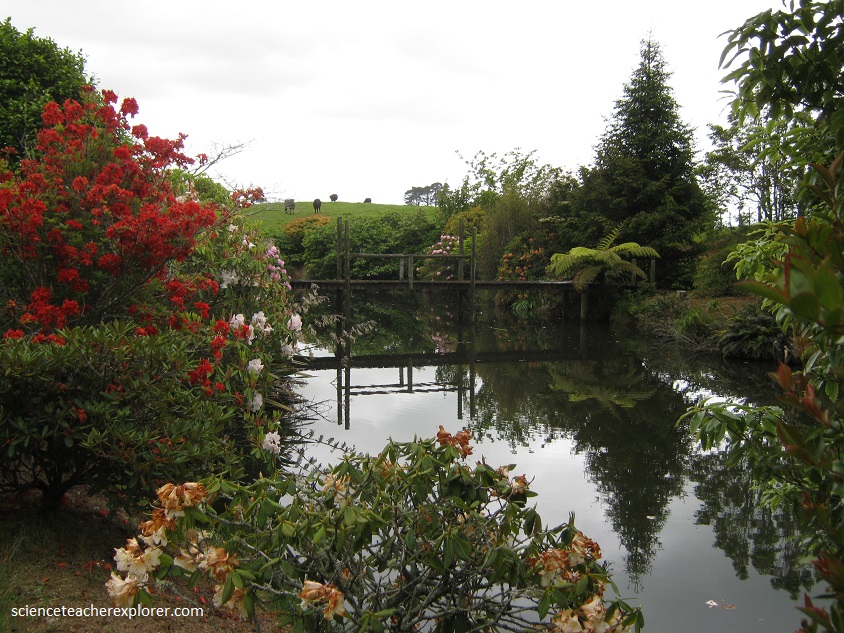Taranaki, N. Z. 2012
In November of 2012, Becky (my wife) and I visited her relatives in Stratford, New Zealand. Stratford resides in the shadow of Mount Taranaki.

We approached Stratford from our Tongariro Alpine Trek on the Whangamomona Road, (pictured below). The 155 km adventure began at Taumarunui and ends in Stratford on the Central plateau, with Mount Ruapehu looming in our rear-view mirror. It follows ancient Maori trade routes and pioneering farm tracks, through ambitious historic settlements, untamed native bush and stunning scenery.

As mentioned, our journey started from Taumarunui, (at the junction of the Whanganui and Ongarue Rivers). Taumarunui holds great significance in both Maori and New Zealand history. It is the point of convergence for the Whanganui, Maniapoto and Tuwharetoa tribes, and has been an important location for New Zealand’s rail network since the pioneering era.

Pictured below, as part of theWhangamomona Road, the single-lane 180m long “Moki Tunnel” was built in 1936 and is known locally as the Hobbit’s hole. Home to fossilized giant crabs, the tunnel’s floor was lowered in 1989 to allow access for triple-decked stock trucks.

Picture below, shortly after the tunnel, a detour along Moki Road leads to a 20 minute walk to Mt. Damper Fall. At 85m this is the North Island’s second highest waterfall, and is a spectacular sight, particularly after heavy rain.

Pictured above, surrounded by native bush, Mt. Damper Falls, spills over a papa bluff and eventually finds it’s way via the Tongaporutu River and to the Tasman Sea in North Taranaki.
Eventually, we make it to Stratford. Named after Shakespeare’s birthplace, the streets of Stratford reflect the Great Bard’s characters. Renowned as the gateway to Egmont National Park, Stratford is the home of Becky’s Aunt Jeannie. Their house had a spectacular view of Mount Egmont.
The elegant volcanic cone of Mount Taranaki, (formerly Mount Egmont), stands alone amid the near-circular remnant of native forest in Egmont National Park.

Taranaki is dormant for now, but it’s 120,000 year life has been violent and changeful. Built from frequent eruptions of lava and tephra, Taranaki once stood more than 2.700 m high, but the mountain has a habit of blowing itself apart.

Mount Taranaki has erupted eight times in the past 500 years, (the last occurred 250 years ago), and volcano experts say it will certainly do so again. These self destructive episodes, coupled with the erosive, drenching west coast rains, have lowered Taranaki to 2518 m.

Maori tales say Taranaki once stood among the other volcanoes in the heart of the North Island. All the volcanoes were gods and warriors and lusted for Pihanga, who stood just beyond their reach. So the mountains fought for her, searing the land in their battles. Tongariro triumphed, and the vanquished volcanoes left the lovers to their solitude. In the night they departed, Taranaki, after grouping the chasm that is now the Whangui River (to the east and pictured below), stopped at the sea, to gaze back upon Pihanga from afar.

Mount Taranaki, together with its parasitic cone of Fanthams Peak, dominates the topography of the Taranaki Peninsula. The lava flows that formed the upper cone have been dated as no older than 7,000 years. Fanthams Peak has lava flows dated as 3,200 years old, (pictured below).

The Taranaki Region of New Zealand is built upon the Median Batholith in the West, and Greywacke Rocks in the East. However, no rocks older than Miocene times are visible at the surface. The dissected hill country to the East of the Taranaki Peninsula, and West of the Central Volcanic Plateau (Tongariro National Park) is composed of soft Miocene to Pleistocene sandstone and mudstone.

Becky and I had just drove through this sedimentary region. In early Miocene times (24 Million Years Ago), plate convergence caused regional compression. Since then, sedimentation has occurred throughout the Taranaki Region, generating the sandstones, soft mudstones, and some limestone.






Hedgehogs are easily recognized by their spines, which are hollow hairs made stiff with keratin. Their spines are not poisonous or barbed and, unlike the quills of a porcupine, do not easily detach from their bodies. Hedgehogs are usually brown, with pale tips to the spines. All species of hedgehogs can roll into a tight ball in self-defense, causing all of the spines to point outwards. The one that was in the garden is a European hedgehog. European hedgehogs were brought to New Zealand by European colonists in the 1870s to remind them of their homeland. They have now spread throughout the country. The general public has a benign attitude to them but conservationists and regional councils regard these animals as pests as they prey on native animals and compete with them for food.